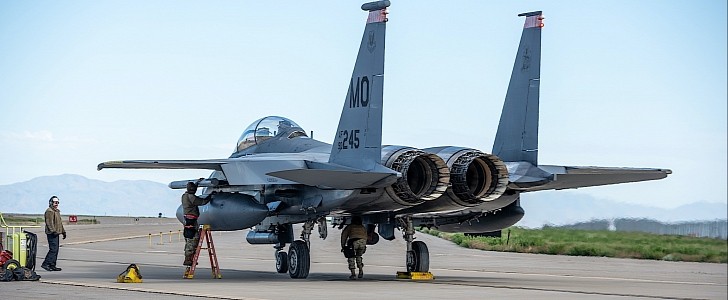Airplanes are by definition very complex pieces of machinery, and by extension military ones even more so. We average Joes only get to see them up and running, and we often tend to forget all the hard work that goes into making these beautiful things airworthy.
Without going as far as saying the image we have here shines a powerful light on all that hard work, it does go a long way in at least giving us a glimpse of what getting an F-15 Strike Eagle ready for (mock) combat entails.
What we see here is an F-15E, sitting on the runway of the Mountain Home Air Force Base in Idaho, just before taking off and heading out for the Raging Gunfighter 22-2 exercise, held at Hill Air Force Base in Utah in the last ten days of May.
We see three “maintenance professionals,” as the USAF calls them, at work, one checking the airplane’s hardpoints attachments, the other going the length of the plane, checking its underbelly, and a third getting ready to get in there as well.
The image is only the tip of the iceberg when it comes to what it takes to service and prepare a fighter jet for operations, especially when it comes to a plane that was born several decades ago.
The dual-role fighter came to be over at McDonnell Douglas (now Boeing) back in the late 1980s as an offshoot of the even older F-15 Eagle, and the present fleet is not that large, comprising “just” a little over 200 of them.
Each is powered by a pair of Pratt & Whitney turbofan engines and is capable of flying at speeds of over Mach 2.5 (1,875 mph/3,018 kph), thus being at the top of the list of fastest military planes out there.
With a single load of fuel (including in three external fuel tanks), the Strike Eagle can fly for as much as 2,400 miles (3,840 km).
What we see here is an F-15E, sitting on the runway of the Mountain Home Air Force Base in Idaho, just before taking off and heading out for the Raging Gunfighter 22-2 exercise, held at Hill Air Force Base in Utah in the last ten days of May.
We see three “maintenance professionals,” as the USAF calls them, at work, one checking the airplane’s hardpoints attachments, the other going the length of the plane, checking its underbelly, and a third getting ready to get in there as well.
The image is only the tip of the iceberg when it comes to what it takes to service and prepare a fighter jet for operations, especially when it comes to a plane that was born several decades ago.
The dual-role fighter came to be over at McDonnell Douglas (now Boeing) back in the late 1980s as an offshoot of the even older F-15 Eagle, and the present fleet is not that large, comprising “just” a little over 200 of them.
Each is powered by a pair of Pratt & Whitney turbofan engines and is capable of flying at speeds of over Mach 2.5 (1,875 mph/3,018 kph), thus being at the top of the list of fastest military planes out there.
With a single load of fuel (including in three external fuel tanks), the Strike Eagle can fly for as much as 2,400 miles (3,840 km).



















